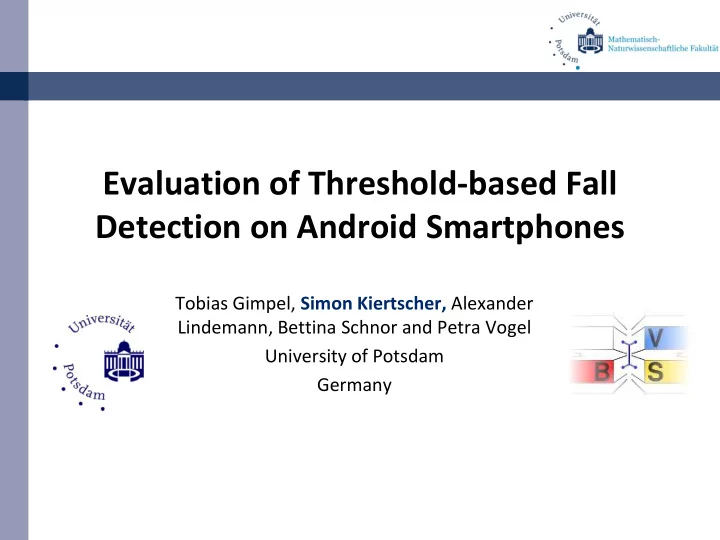

Evaluation of Threshold-based Fall Detection on Android Smartphones Tobias Gimpel, Simon Kiertscher, Alexander Lindemann, Bettina Schnor and Petra Vogel University of Potsdam Germany
Before we start … 2
Outline • Motivation • Threshold-based fall detection • Experiments and results • Evaluation of fall detection applications in the Google Play Store • Conclusion and future work 3
Motivation Why is fall detection necessary? • Elderly people have a high risk of falls • 33% fall unintentionally each year [Mellone et al., 2012] • Especially falls with loss of consciousness are dangerous fast help is needed 4
Motivation Why fall detection on smartphones? • Easily accessible • Cheap in contrast to dedicated hardware • Future generations will have one by default • Portability Why no bracelets? • Fall detection works bad if device is worn at the arm • Device should be close to the center of the body 5
Alternatives Smart Cameras for fall detection: • Restricted to dedicated areas (garden?) • Cost intensive • Blind spots? • Privacy? Sensor mats: • Restricted to dedicated areas (garden?) • Cost intensive • Stability? • Hygiene? 6
Threshold-based fall detection Fall characteristics: 7
Fall detection phases 8
Different implementations of the phases Karth FF* Karth* Mehner FF** Mehner** Gimpel Free Fall X X X Impact X X X X X Stable A X X X Stable B X X Orientation A X X Orientation B X X Orientation C X *[Karth et al. 2012] (from our working group) **[Mehner et al. 2013] 9
Differences in the orientation phase Orientation A (Karth) • Moving average last value before possible fall which is > 0,9g and < 1,1g compute vector angle between first vector after possible fall • Angle > 45° fall is assumed Orientation B (Mehner) • Mean value of the last 100 values for each axis before the possible fall vs. mean value of the 100 values for each axis after the possible fall • Difference > 0,4g fall is assumed Orientation C (Gimpel) • Mean value of the last 100 values for each axis before the fall vs. mean value of the 100 values for each axis after the presumed fall • Values are used to compute the angle between the vectors • Angle > 60° fall is assumed 10
Evaluation • HTC Desire 816 and Sony Xperia V • Worn in a funny bag at the hip in front • Front, left and right falls • 3 probands Age Front falls Right falls Left falls Device 23 4 3 5 Sony 29 10 10 10 Sony 55 4 3 3 HTC 11
Fall detection results of proband 23 12
Fall detection results of proband 55 13
Fall detection results of proband 29 14
Activities of daily life (ADL) • Fall detection algorithms have to distinguish between ADLs and real falls • 2 probands • False positives: Age Duration Karth FF Karth Mehner FF Mehner Gimpel 55 286h 24 57 0 5 2 72 11h 0 3 0 1 0 15
Conclusion on fall detection • [Mehner et al. 2013] proposed to exclude the free fall phase • Our ADL experiments show that the FF phase is vital for a low false positive rate • Karth FF, Mehner FF, Gimpel • Mehner FF performed worse 34,6% overall detection rate but 0 false positives • Karth FF and Gimple are comparable good 94% / 84% overall detection rate 24 / 2 false positives 16
Google Play Store fall detection apps • September 2014 • 22 hits if searched for “fall detection” • 13/22 are related to the topic • 2/13 were commercial applications (4 € tested / 120 € not tested) • 8/13 passed our exclusion reasons 17
Exclusion reasons Following characteristics resulted in an exclusion for further tests: • Failed/impossible installation • No reaction of application after installation • The need to register for a phone call in a foreign country • The phone call destination is not obvious 18
Further tests Specificity tests: • Fixed set of ADL (walking around, climbing stairs, sitting down on chair) • Done in varying speed in a 10 minutes window • Smartphone was in a trousers pocket Sensitivity tests • 10 falls in forward direction (by proband 23 and proband 55) 19
Results Name FP prob23 prob55 detection rate T3LAB Fall Detector no 1/5 3/5 40% iCare Personal Emergency Alert no 5/5 2/5 70% Smart Fall Detection no 0/5 0/5 0% Emergency Fall Detector no 0/5 0/5 0% Fall Detector yes 0/5 0/5 0% Fade: fall detector yes 3/5 3/5 60% iFall: Fall Monitoring System yes 0/5 2/5 20% SecureMe Active (commercial) yes 2/5 4/5 60% 20
Conclusion and Future Work • Our algorithm (Gimpel) is a good compromise between low false positive rate (2 within 12,3d) and high fall detection rate (84%) • Free fall phase is vital to distinguish between ADL and real fall • Only one public available fall detection application with acceptable results (for Google) • Testing of applications available in other stores and/or for other phones like iPhone (App Store) 21
Thank you for your attention! Any questions? Contact: {allindem, kiertscher, pvogel, schnor}@cs.uni- potsdam.de www.cs.uni-potsdam.de/bs/ research/projectAl.html 22
Recommend
More recommend